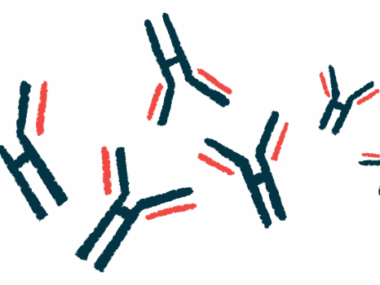Autoantibodies linked to organ damage in SSc overlap syndrome
Certain autoantibodies tied to lungs and kidneys, study finds
Written by |

The specific self-reactive antibodies (autoantibodies) of people with systemic sclerosis (SSc) overlap syndrome — a condition in which SSc patients have clinical signs and autoantibodies related to other connective tissue diseases — are tied to organ damage and SSc prognosis, according to a single-center study in China.
Patients with anti-Scl-70 antibodies were more likely to have lung and kidney involvement, while anti-centromere antibodies (ACA) were tied to a lower risk of lung involvement, the study found.
“Rheumatologists may pay more attention on autoantibodies in the clinical practice, so as to provide evidence for further accurate disease assessment and treatment,” the researchers wrote.
The study, “Autoantibodies in systemic sclerosis overlap syndrome and their correlation with organ damage and survival,” was published in Rheumatology.
SSc is an autoimmune disease characterized by the accumulation of scar tissue in the skin and potentially internal organs, including the heart, kidney, lungs, and digestive tract. SSc overlap syndrome patients have clinical features or autoantibodies related to connective tissue disorders such as rheumatoid arthritis (RA), systemic lupus erythematosus (SLE) — the most common form of lupus — and Sjögren’s disease.
Organ damage link
“Several autoantibodies were considered to be associated with clinical characteristics in SSc,” the researchers wrote. “However, when SSc overlaps with another connective tissue disease, the frequency and clinical role of these antibodies, especially their correlation with organ damage, remain unclear.”
The researchers, from Peking University People’s Hospital in China, conducted a retrospective analysis of 141 patients with SSc overlap syndrome. Most patients were women (94.3%) with a mean age of 55.9, and were followed up for a mean of 11.2 years.
One-third of the participants had SSc-Sjögren’s disease overlap, followed by SSc-RA (16.3%), SSc with SLE (15.6%), and SSc with polymyositis/dermatomyositis (PM/DM, 8.5%). PM and DM are types of myositis characterized by muscle inflammation.
The onset of SLE occurred before SSc in patients with those two overlapping conditions, while the opposite was seen in RA and PM/DM. Sjögren’s disease and SSc occurred at about the same time.
Almost all patients (95.7%) had antinuclear autoantibodies, which target proteins in the cell nucleus. Other common antiantibodies included anti-Ro-52 (44%), ACA (39%), and anti-Scl-70 (18.4%). Patients with anti-Scl-70 antibodies were more likely to have interstitial lung disease (92.3% vs. 61.6%) and scleroderma renal crisis (8.7% vs. 1%) than patients without these antibodies. Interstitial lung disease is a condition in which the lungs become scarred, and scleroderma renal crisis is characterized by sudden high blood pressure, kidney failure, and heart failure.
Anti-Scl-70 antibodies were associated with a higher prevalence of finger ulcers (open sores) in SSc-Sjögren’s, SSc-SLE, and SSc-PM/DM patients, and a lower risk of heart involvement in SSc-RA.
ACA antibodies were generally associated with a lower prevalence of interstitial lung involvement (47.2% vs. 78.8%). Also, SSc-Sjögren’s patients with these antibodies had a higher frequency of telangiectasis — small blood vessels that become dilated at the skin surface — limb numbness, and higher usage of glucocorticoids.
In those with SSc-SLE overlap, such antibodies were also associated with more oral ulcers and with longer disease duration.
Anti-Ro-52 antibodies were associated with a higher frequency of scleroderma renal crisis and with low platelet levels in SSc-SLE patients, and with more frequent heart involvement, longer disease duration, and more common use of glucocorticoids in SSc-Sjögren’s.
Ten patients died during follow-up. The direct causes of death included heart failure in three patients, liver failure in one, and severe pneumonia, an infection that inflames the air sacs of the lungs, in another.
Patients who died were older at disease onset (49.5 vs. 40) but had shorter disease duration (13 years vs. 15.5 years). They were also significantly more likely to have skin rash associated with myositis (30% vs. 7.4%) and muscle pain (50% vs. 16.4%). Scleroderma renal crisis (33% vs. 0%), pulmonary hypertension — high blood pressure in the blood vessels that supply the lungs (60% vs. 18.4%)— and anemia (low levels of red blood cells or of hemoglobin to carry oxygen to the body’s tissues; 90% vs. 33.6%) were also more common in this group than in patients who remained alive.
Further analysis revealed that both pulmonary hypertension and SRC were independent risk factors for survival.
“The results showed the presence of relationship between autoantibodies and clinical feature, especially organ damage,” and “may help to further understand and evaluate the disease and make better clinical decisions,” the researchers wrote.





